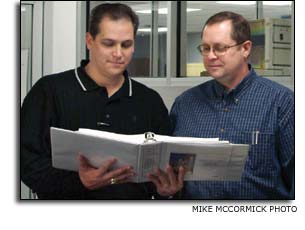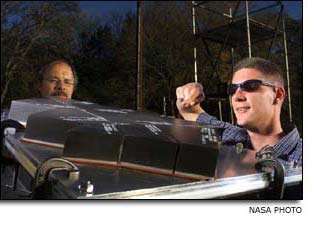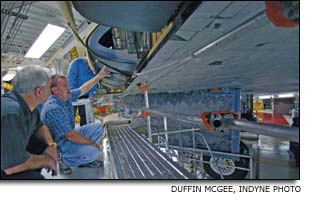Toward a safer, more reliable
engine
 Mike
Stokes, Boeing Integrated Defense System manager of the Controller
Software Laboratory for the Space Shuttle Main Engine program in
Huntsville, Ala., said he and his team have been looking forward
to flying again since the day Space Shuttle Columbia was
lost. Mike
Stokes, Boeing Integrated Defense System manager of the Controller
Software Laboratory for the Space Shuttle Main Engine program in
Huntsville, Ala., said he and his team have been looking forward
to flying again since the day Space Shuttle Columbia was
lost.
Stokes and the Controller Software Laboratory team develop the
Space Shuttle Main Engine Controller software, which controls engine
operation during flight. A computer mounted on each of the three
Space Shuttle Main Engines monitors almost 90 sensors-including
engine pressures, temperatures, propellant flow rates, vibrations
and speed-as well as dozens of other engine indications, he said.
"The sensors are monitored 50 times per second for the duration
of ascent, and this information is then used to control the engine,
make assessments of its health, and take any necessary action to
keep the astronauts and orbiter safe," he added.
FULL STORY >>

Tests helping to solve riddle
of tile damage
 The
vivid images of foam coming off the external tanks of Space Shuttle
Columbia during ascent reminded the world that human space
flight can be dangerous. As NASA and its team of contractors get
ready for return to flight this fall, one of their priorities is
to understand better the impact of debris on the Space Shuttle tiles. The
vivid images of foam coming off the external tanks of Space Shuttle
Columbia during ascent reminded the world that human space
flight can be dangerous. As NASA and its team of contractors get
ready for return to flight this fall, one of their priorities is
to understand better the impact of debris on the Space Shuttle tiles.
Shawn Sorenson, Boeing IDS tile-testing project engineer and coordinator,
sees the results of tile testing every day at the foam test center
at Southwest Research Institute in San Antonio. One of the recommendations
of the Columbia Accident Investigation Board investigation
was to improve the capability to assess what damage debris such
as ice or insulating foam from the external tank could inflict on
the orbiter.
FULL STORY >>

Back in the Space Shuttle tile
business
 Boeing
Integrated Defense Systems employees in Palmdale, Calif., once thought
that their tile production days were over when the company decided
to move the Orbiter Maintenance and Modification process to United
Space Alliance facilities in Florida. But today, Boeing engineers
and technicians in Palmdale are back in the business of manufacturing
tiles for the Space Shuttle. Boeing
Integrated Defense Systems employees in Palmdale, Calif., once thought
that their tile production days were over when the company decided
to move the Orbiter Maintenance and Modification process to United
Space Alliance facilities in Florida. But today, Boeing engineers
and technicians in Palmdale are back in the business of manufacturing
tiles for the Space Shuttle.
That's because the loss of the Space Shuttle Columbia
and subsequent tile impact testing recommended by the Columbia Accident
Investigation Board have created a requirement for the manufacture
of large amounts of tile. In these tests, various substances, such
as foam and ice, are being shot from compressed air guns at different
angles and speeds onto new tile "targets." Structural and thermal
engineering communities are using data from the tests to improve
their damage prediction capabilities.
FULL STORY >>

Long hours searching for clues
and cracks
 Dave
Lubas, Boeing Integrated Defense Systems materials and process engineer,
was at home preparing to celebrate his son's birthday on Feb. 1,
2003. He had an ear cocked for the familiar sonic boom that would
signal Space Shuttle Columbia's reentry into the atmosphere
over Florida. But the boom never came, and Lubas knew something
was wrong. A telephone call shortly after 9 a.m. confirmed his worst
suspicions: Columbia and its crew had been lost. Dave
Lubas, Boeing Integrated Defense Systems materials and process engineer,
was at home preparing to celebrate his son's birthday on Feb. 1,
2003. He had an ear cocked for the familiar sonic boom that would
signal Space Shuttle Columbia's reentry into the atmosphere
over Florida. But the boom never came, and Lubas knew something
was wrong. A telephone call shortly after 9 a.m. confirmed his worst
suspicions: Columbia and its crew had been lost.
The 12-year Boeing employee immediately volunteered to help with
debris identification. Pieces of Columbia strewn across
vast areas of Texas were being trucked into the Kennedy Space Center,
Fla. Lubas was assigned to the team that was reconstructing the
leading edge of Columbia's left wing, where investigators
believed a fatal breach permitted hot gases to enter the orbiter
at the start of the crew's re-entry.
FULL STORY >>
|

